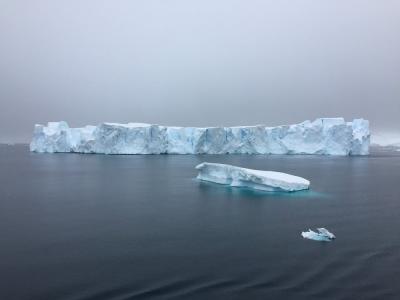Polar Imbalance: Understanding Differences in How the Arctic and Antarctic Respond to Increased Greenhouse Gases
Polar climates might be expected to respond similarly to changing atmospheric conditions, but observations show the Arctic has warmed more rapidly in response to increased carbon dioxide levels than the Antarctic. One explanation for the Antarctic response has been the uptake—or absorption—of atmospheric heating by the Southern Ocean. Researchers at the U.S. Department of Energy’s Pacific Northwest National Laboratory showed that the different responses between the Arctic and Antarctic also arose because the ocean triggered environmental feedbacks that caused additional warming over the Arctic—not from differences in how the subpolar oceans responded to warming from greenhouse gases.
This study provides an alternative explanation for why the Arctic warms more than the Antarctic. Researchers found stronger and more destabilizing feedbacks occurring over the Arctic than over the Antarctic. These destabilizing feedbacks increase the top-of-atmosphere energy imbalance, so the Earth must warm even more to reach equilibrium. Future studies could consider why the Arctic and Antarctic experience different feedbacks, not necessarily differences in the ocean response to warming.
Greenhouse gas emissions from human activities affect the planet globally, but nowhere more so than over the Arctic—a phenomenon known as polar amplification. Surprisingly, the response over the Antarctic is much more muted than over the Arctic. Previous research attributed this difference to the large amount of heat being absorbed into the deep Southern Ocean, cooling the Southern Hemisphere. Researchers analyzed model results and found that the ocean heat uptake might not be the sole cause. They then designed experiments to test that idea.
Results showed that the weaker response over the Antarctic was partly due to weaker intrinsic sensitivity to both greenhouse gas forcing and ocean heat transport and uptake. The study indicated that the Arctic had greater local climate sensitivity (i.e., a greater surface temperature response) to doubling of carbon dioxide from preindustrial conditions. In addition to warming, carbon dioxide causes changes in how the ocean takes up heat from the atmosphere. Results showed that those changes in the ocean only served to increase local sensitivity over the Arctic and do not produce that same impact over the Antarctic. Even climate models with similar amounts of heat absorbed into the deep ocean in both hemispheres warmed more over the Arctic than over the Antarctic. Similar increases in winter heat transport to the polar oceans in both hemispheres triggered stronger and more destabilizing feedbacks over the Arctic than over the Antarctic. The most important feedbacks included the ice-albedo (reflectivity that speeds up ice melt) and lapse rate (atmospheric temperature change with an increase in altitude) feedbacks. Therefore, greater warming can be expected over the Arctic than over the Antarctic. This holds true even if changes in ocean heat transport or uptake are similar in both hemispheres.

